Showing Spotlights 433 - 440 of 627 in category All (newest first):
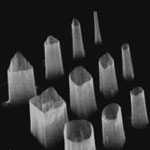 Among the many challenges that researchers have to overcome in developing bottom-up nanotechnology fabrication techniques and processes, the requirement for extremely precise, nanometer-scale control of positioning and shaping of objects is one of the most vexing. New work by a team of scientists in Korea demonstrates the position- and shape-controlled growth of nanoarchitectures using the selective growth of nanowalls with conventional lithography and catalyst-free metal organic vapor-phase epitaxy (MOVPE). This presents a significant advance towards the fabrication of artificial 1D and 2D nanomaterials as functional components in many integrated electronic and photonic devices.
Among the many challenges that researchers have to overcome in developing bottom-up nanotechnology fabrication techniques and processes, the requirement for extremely precise, nanometer-scale control of positioning and shaping of objects is one of the most vexing. New work by a team of scientists in Korea demonstrates the position- and shape-controlled growth of nanoarchitectures using the selective growth of nanowalls with conventional lithography and catalyst-free metal organic vapor-phase epitaxy (MOVPE). This presents a significant advance towards the fabrication of artificial 1D and 2D nanomaterials as functional components in many integrated electronic and photonic devices.
Jan 26th, 2009
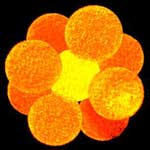 Colloidal materials have been playing a major role in many research fields such as chemistry, materials science, condensed matter physics, applied optics, fluid dynamics, and biology. Most of these studies require the use of monodisperse colloidal particles with uniformity in shape, size, composition, structure and surface properties. Both our current understanding of various physical phenomena and our capability to fabricate new functional materials have been considerably enriched by the development of synthetic strategies that are capable of generating copious quantities of colloidal entities of good size uniformity. Nevertheless, most of the available monodisperse colloidal materials are spherical because this represents a thermodynamically favorable state in terms of surface energy. This strongly limits the number of new structures which can be engineered by using these colloids as building blocks. A novel synthetic route can now produce a full set of new non-spherical, binary colloids with regular morphology in a high yield.
Colloidal materials have been playing a major role in many research fields such as chemistry, materials science, condensed matter physics, applied optics, fluid dynamics, and biology. Most of these studies require the use of monodisperse colloidal particles with uniformity in shape, size, composition, structure and surface properties. Both our current understanding of various physical phenomena and our capability to fabricate new functional materials have been considerably enriched by the development of synthetic strategies that are capable of generating copious quantities of colloidal entities of good size uniformity. Nevertheless, most of the available monodisperse colloidal materials are spherical because this represents a thermodynamically favorable state in terms of surface energy. This strongly limits the number of new structures which can be engineered by using these colloids as building blocks. A novel synthetic route can now produce a full set of new non-spherical, binary colloids with regular morphology in a high yield.
Jan 23rd, 2009
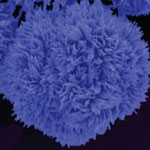 The thing with technology is that the science behind it isn't good or bad but the way it is used could make all the difference. There are plenty of examples throughout history. Military nanotechnology is a good present day example. And we don't even need to talk about the weird, far-out stuff like nanobots and the Casimir force. Take explosives. While on one side there is research going on to improve high explosives through nanoscale structuring, other research teams are putting a lot of effort into detecting ever smaller trace amounts of explosives and building the ultimate nanoscale bomb dog. A recent example has been demonstrated by scientists in China, who obtained organic super-nanostructures via a simple solution process, and, for the first time, demonstrated that such structures can be applied as chemosensors to detect explosives.
The thing with technology is that the science behind it isn't good or bad but the way it is used could make all the difference. There are plenty of examples throughout history. Military nanotechnology is a good present day example. And we don't even need to talk about the weird, far-out stuff like nanobots and the Casimir force. Take explosives. While on one side there is research going on to improve high explosives through nanoscale structuring, other research teams are putting a lot of effort into detecting ever smaller trace amounts of explosives and building the ultimate nanoscale bomb dog. A recent example has been demonstrated by scientists in China, who obtained organic super-nanostructures via a simple solution process, and, for the first time, demonstrated that such structures can be applied as chemosensors to detect explosives.
Jan 16th, 2009
 Civilization as we know it would, literally, fall apart without techniques to join materials together. With its historic development tracing back to the Bronze Age, welding has been one of the key technologies that serves modern industry in broad areas such as construction, manufacturing, and engineering. As we have reported in a previous Nanotechnology Spotlight, this Bronze Age technique could prove very useful in building complex nanostructures. Researchers at the University of Sheffield in the UK have now demonstrated the ability to reliably weld individual nanowires and nanoobjects into complex geometries with controllable junctions. This represents a significant breakthrough for the current and future bottom-up localized assembly, integration, and repair of micro- and nanodevices.
Civilization as we know it would, literally, fall apart without techniques to join materials together. With its historic development tracing back to the Bronze Age, welding has been one of the key technologies that serves modern industry in broad areas such as construction, manufacturing, and engineering. As we have reported in a previous Nanotechnology Spotlight, this Bronze Age technique could prove very useful in building complex nanostructures. Researchers at the University of Sheffield in the UK have now demonstrated the ability to reliably weld individual nanowires and nanoobjects into complex geometries with controllable junctions. This represents a significant breakthrough for the current and future bottom-up localized assembly, integration, and repair of micro- and nanodevices.
Jan 12th, 2009
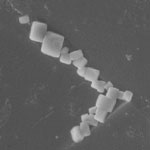 The performance of devices like organic light emitting diodes (OLEDs), flexible solar cells, or plastic electronics is sensitive to moisture because water and oxygen molecules seep past the protective plastic layer over time and degrade the organic materials which form the core of these products. To protect these sensitive devices, barrier technologies have been developed that protect them from environmental degradation. State-of-the-art barrier materials employ metal oxide thin films, commonly from aluminum or silicon oxides, which provide excellent protection from atmospheric oxygen and water, but still suffer from problems. A new study demonstrates a nanocomposite material that can initiate self-healing upon the influx of water through pores and cracks by delivering titanium dioxide nanoparticles to the defective site, which ultimately slows the rate of moisture diffusion to the reactive electronic device.
The performance of devices like organic light emitting diodes (OLEDs), flexible solar cells, or plastic electronics is sensitive to moisture because water and oxygen molecules seep past the protective plastic layer over time and degrade the organic materials which form the core of these products. To protect these sensitive devices, barrier technologies have been developed that protect them from environmental degradation. State-of-the-art barrier materials employ metal oxide thin films, commonly from aluminum or silicon oxides, which provide excellent protection from atmospheric oxygen and water, but still suffer from problems. A new study demonstrates a nanocomposite material that can initiate self-healing upon the influx of water through pores and cracks by delivering titanium dioxide nanoparticles to the defective site, which ultimately slows the rate of moisture diffusion to the reactive electronic device.
Dec 9th, 2008
 Scientists are intensely researching how animals like spiders and geckos generate the high adhesion force that allows them to cling to walls and walk on ceilings, feet over their head. While this research so far has focused on novel materials like carbon nanotubes to replicate spider feet and gecko toes, a key challenge for materials engineers is the scaling up of such materials from small animals to, say, spiderman gloves that support a fully grown human. Complementing the ongoing gecko biomimetic materials research, Nicola M. Pugno, an Associate Professor of Structural Mechanics at the Politecnico di Torino in Italy, has developed what he termed Adhesive Optimization Laws.
Scientists are intensely researching how animals like spiders and geckos generate the high adhesion force that allows them to cling to walls and walk on ceilings, feet over their head. While this research so far has focused on novel materials like carbon nanotubes to replicate spider feet and gecko toes, a key challenge for materials engineers is the scaling up of such materials from small animals to, say, spiderman gloves that support a fully grown human. Complementing the ongoing gecko biomimetic materials research, Nicola M. Pugno, an Associate Professor of Structural Mechanics at the Politecnico di Torino in Italy, has developed what he termed Adhesive Optimization Laws.
Dec 3rd, 2008
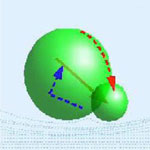 Advances in micro- and nanoscale engineering have led to various mobile devices that either can move on solids or swim in fluids. Researchers are applying various strategies to designing nanoscale propulsion systems by either using or copying biological systems such as the flagellar motors of bacteria or by employing various chemical reactions. Many of these approaches are fairly complex and not necessarily suited for large-scale deployment in practical applications. Scientists have theorized about simpler designs for mechanical swimmers that avoid the complexities of biological mechanisms and use very few degrees of freedom.
Researchers in Spain have now demonstrated the experimental realization of a simple device made by microscopic colloidal particles which can be externally controlled and propelled at low Reynolds number condition, i.e. when the viscosity of the fluid dominates over the inertia of the object. This is the same condition that governs the motion of bacteria such as E. Coli or other micro- or nanoscale objects that move in a fluid.
Advances in micro- and nanoscale engineering have led to various mobile devices that either can move on solids or swim in fluids. Researchers are applying various strategies to designing nanoscale propulsion systems by either using or copying biological systems such as the flagellar motors of bacteria or by employing various chemical reactions. Many of these approaches are fairly complex and not necessarily suited for large-scale deployment in practical applications. Scientists have theorized about simpler designs for mechanical swimmers that avoid the complexities of biological mechanisms and use very few degrees of freedom.
Researchers in Spain have now demonstrated the experimental realization of a simple device made by microscopic colloidal particles which can be externally controlled and propelled at low Reynolds number condition, i.e. when the viscosity of the fluid dominates over the inertia of the object. This is the same condition that governs the motion of bacteria such as E. Coli or other micro- or nanoscale objects that move in a fluid.
Dec 1st, 2008
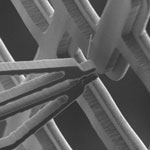 Nanotechnology researchers are actively working on the beginnings of various nanorobotic systems that one day could lead to automated, assembly-line type nanofabrication processes. Last year we reported on a nanogripper, a kind of a robotic 'hand' some ten thousand times smaller than a human hand. This 'pick-and-place' device used a silicon gripper which was controlled by a nanorobotic arm and was capable of picking up a carbon nanofiber and fix it onto the tip of an atomic force microscope cantilever. One of the problems that is vexing researchers is that the nanoscale miniaturization of these grippers comes at the cost of reduced strength - the smaller the gripper, the weaker it becomes. Therefore what is needed is a gripper design that is strong enough yet sufficient flexible and small to handle tough materials like carbon nanotubes.
Nanotechnology researchers are actively working on the beginnings of various nanorobotic systems that one day could lead to automated, assembly-line type nanofabrication processes. Last year we reported on a nanogripper, a kind of a robotic 'hand' some ten thousand times smaller than a human hand. This 'pick-and-place' device used a silicon gripper which was controlled by a nanorobotic arm and was capable of picking up a carbon nanofiber and fix it onto the tip of an atomic force microscope cantilever. One of the problems that is vexing researchers is that the nanoscale miniaturization of these grippers comes at the cost of reduced strength - the smaller the gripper, the weaker it becomes. Therefore what is needed is a gripper design that is strong enough yet sufficient flexible and small to handle tough materials like carbon nanotubes.
Nov 26th, 2008
 Among the many challenges that researchers have to overcome in developing bottom-up nanotechnology fabrication techniques and processes, the requirement for extremely precise, nanometer-scale control of positioning and shaping of objects is one of the most vexing. New work by a team of scientists in Korea demonstrates the position- and shape-controlled growth of nanoarchitectures using the selective growth of nanowalls with conventional lithography and catalyst-free metal organic vapor-phase epitaxy (MOVPE). This presents a significant advance towards the fabrication of artificial 1D and 2D nanomaterials as functional components in many integrated electronic and photonic devices.
Among the many challenges that researchers have to overcome in developing bottom-up nanotechnology fabrication techniques and processes, the requirement for extremely precise, nanometer-scale control of positioning and shaping of objects is one of the most vexing. New work by a team of scientists in Korea demonstrates the position- and shape-controlled growth of nanoarchitectures using the selective growth of nanowalls with conventional lithography and catalyst-free metal organic vapor-phase epitaxy (MOVPE). This presents a significant advance towards the fabrication of artificial 1D and 2D nanomaterials as functional components in many integrated electronic and photonic devices.
 Subscribe to our Nanotechnology Spotlight feed
Subscribe to our Nanotechnology Spotlight feed





